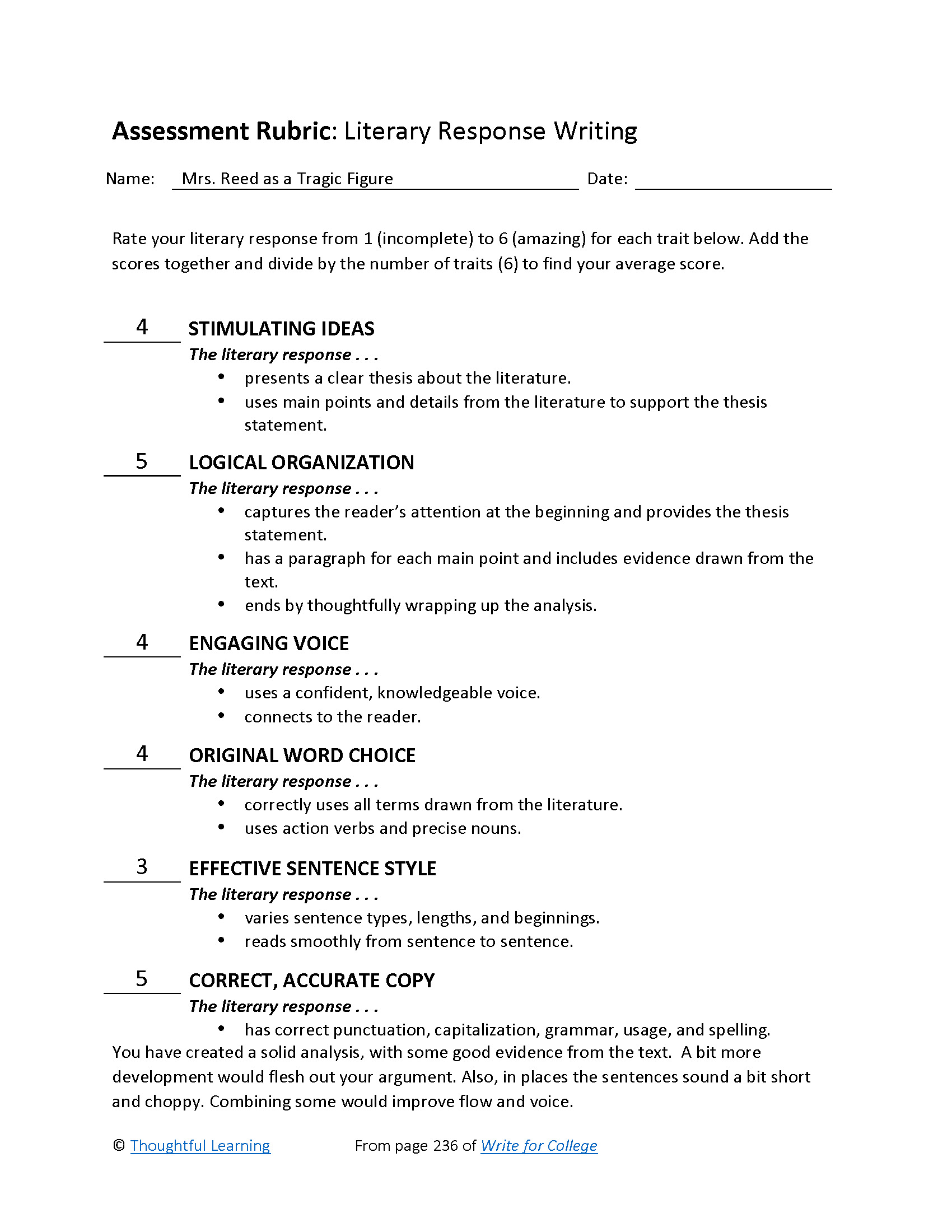Student Model
Mrs. Reed as a Tragic Figure
Readers who had to pick a favorite character from Charlotte Brontё's Jane Eyre probably would not mention Mrs. Reed. She spoils her own children and treats Jane with disdain. But Mrs. Reed is really a tragic figure because all of her problems stem from her inability to love the young girl she must care for. Is it really Mrs. Reed's fault? She can't change her feelings. But love is more than a feeling. It is a decision to treat another person with respect. Because Mrs. Reed can't make that decision, she makes herself and everyone around her miserable.
Early on in the book, Mrs. Reed agrees to take care of Jane, but then she really doesn't. While outwardly providing for Jane's needs, Mrs. Reed withholds affection from her and treats her abusively, especially in contrast to her doting treatment of her own children. John is Mrs. Reed's "only darling." She gives him everything, even though he is a brat. Meanwhile, Jane does everything she is supposed to do but is considered "naughty and tiresome, sullen and sneaking, from morning to noon, from noon to night" (Brontё 14). Mrs. Reed also favors her beautiful, curly-headed and blue-eyed daughter Georgiana over Jane. Georgiana grows up believing she is a gift to the world. So as an adult, she selfishly seeks only to be adored. Because Jane receives no such admiration, she turns herself toward study and earns an education that neither Georgiana nor Eliza ever receive. Mrs. Reed has accidentally taught her children to be dependent, and they suffer in adulthood. Unwittingly Mrs. Reed teaches Jane to be independent, and she thrives.
Mrs. Reed could have escaped her tragic fate if she had seen where she herself was at fault. She neglects and abuses Jane at home and then banishes her to Lowood. Though the blame should rest with Mrs. Reed, she instead blames Jane: “I could not forget your conduct to me, Jane” (Brontё 256). Instead of learning from her mistakes and asking for forgiveness, Mrs. Reed only doubles down on her sins, spreading the lie that Jane has died. This denialism eventually leads Mrs. Reed to have a stroke, so that she can't even recognize Jane anymore. Brontё is showing how willful rejection of reality leads to disconnection from everything and everyone.
Mrs. Reed is alienated from Jane and her whole family. John commits suicide when his mother will no longer bail him out from gambling debts. Georgiana spends her adult life seeking status and approval in society and largely abandons her mother. Eliza becomes a nun, shutting herself off from the wealth and position of her household. As Mrs. Reed lies dying, Jane goes to offer her forgiveness: " ' Love me, then, or hate me, as you will,' I said at last, 'you have my full and free forgiveness: ask now for God's and be at peace' " (Brontё 257). But Mrs. Reed is incapable of loving in death just as in life. Eliza notes that her mother died because of a troubled life, in a sense blaming Jane as well. Neither she nor Jane shed a tear at her passing.
So, who is to blame for Mrs. Reed's misery? She, herself, of course. But that's the nature of a tragic figure—a person destroyed by a fatal flaw. For Mrs. Reed, the fatal flaw was a lack of love and an inability to recognize that flaw. The more she blamed and punished Jane, the more the blame and punishment fell on Mrs. Reed. One woman made a life for herself despite all the trouble heaped on her. The other had her life taken away because of all the trouble she heaped on others.

Rubric


Mrs. Reed as a Tragic Figure by Thoughtful Learning is licensed under a Creative Commons Attribution-NonCommercial-ShareAlike 4.0 International License.
Based on a work at k12.thoughtfullearning.com/assessmentmodels/mrs-reed-tragic-figure.